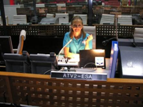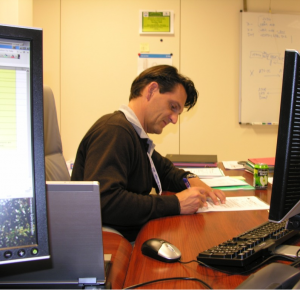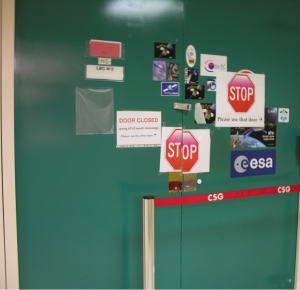This report came in overnight from Charlotte Beskow in Kouruo,who sent her mail around 04:00 CET. The folks at Kourou had a very long day! – DGS
We have just finished the official dress rehearsal!
This means that Kourou’s Centre Spatial Guyanais (CSG) together with the ground stations, ATV-CC and ATV itself have simulated the countdown and the actual flight to ensure that all is ready for launch next week on Tuesday, 15 February.
This type of exercise is very demanding and requires a lot of preparation and coordination to ensure that communication run smoothly. If we look only at our interface with ATV-CC, there are four separate groups playing a role: the Mission Manager here in the Launcher Control Room at Kourou, technical people nearby in the room that hosts the Electrical Ground Support Equipment (our cable interface to ATV), the ATV-CC Control Centre team in Toulouse and the Engineering Support team, also in Toulouse.
To that, we must add the CSG people working on the radar stations (three in French Guyana) plus the tracking stations – in French Guyana, one on a ship in the Atlantic, one in the Azores, two different tracking stations in Australia and one in New Zealand (I apologise in advance for whichever station I have forgotten).
Just imagine trying to set up the communication links for all that! And include also the logistics teams, arranging travel, arranging meals for those who are too far away from the canteen to get anything to eat, etc., etc.
During the course of the rehearsal, we activate ATV, check that all is OK, upload the final parameters, and – shortly before H0 (launch time) – we switch ATV to the internal power supply and start the mission plan. During the many hours this takes, several engineers are watching over every important aspect of the vehicle, to ensure that all is OK and that conditions are OK to proceed to the next step.
The atmosphere in the Launcher Control Room is very relaxed when all is going well. The CSG staff have done this any number of times and they know their procedures very well. Few people use the headsets, preferring the loudspeaker function since this has several advantages: (1) You can keep a good situational awareness since you have a rough idea of what is happening elsewhere, (2) You can make a phone call without having the phone collide with the headset earpiece and you can get up from your seat without being caught short by the cable attached between your head and the keyset. Last but not least, it is easier to greet people without the headset on, at least if you are a woman.
As the client, the dress rehearsal is very important. CSG teams know their procedures but, on the other hand, we from ESA do not do this every month! The last time was March 2008, for ATV-1, and neither Nico, myself nor Olivier (from Astrium) were present at the time – so we are doing it for the first time. It is fun – but you have to stay alert. It is easy to get side-tracked by some interesting discussion [or by incessant email from the ATV blog editors 🙂 – Ed.] and miss your call. When this happens, the person expecting your message has no idea why you are not sticking to the procedure, and probably sifts through numerous ‘what-if-then’ scenarios trying to figure out how to react.
It is important to remember that while those of us who sit in Jupiter have access to lots of information, people at the remote sites do not. Information is sure to flow upwards, but we must also remember to pass it back down, even if only to say that all is OK – especially on a day like today. During simulations such as this, little actually goes on after the notional lift off so the control centre staff will sit there, without any real telemetry on their screens, waiting for the announcements that all is going well. Separation occurs 1 hour after launch – and that is quite a long time to wait.
We started at 09:00 this morning Kourou time [12:00 GMT = 13:00 CET – Ed.] and when I left at 21:00 to go back to the office to close a few actions, they were still in contact with the ground stations. We could hear the announcements on the radio link in the building as we were busy putting the finishing touches into the presentations for tomorrow’s Launch Readiness Review.




 Automated Transfer Vehicle page
Automated Transfer Vehicle page ATV blog archive
ATV blog archive
Discussion: no comments